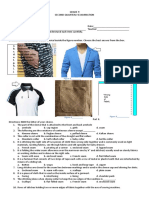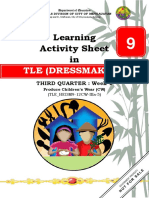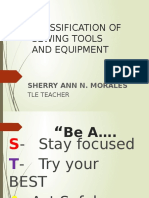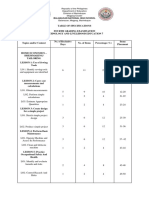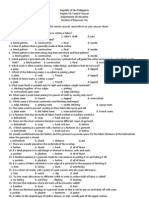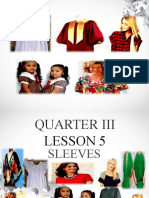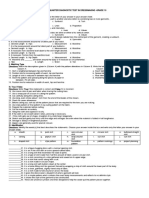Lesson Plan
Lesson Plan
Uploaded by
Tobias AndoyCopyright:
Available Formats
Lesson Plan
Lesson Plan
Uploaded by
Tobias AndoyCopyright
Available Formats
Share this document
Did you find this document useful?
Is this content inappropriate?
Copyright:
Available Formats
Lesson Plan
Lesson Plan
Uploaded by
Tobias AndoyCopyright:
Available Formats
POLYTECHNIC UNIVERSITY OF THE PHILIPPINES College of Education Anonas St., Sta.
Mesa, Manila
LESSON PLAN IN: HOME ECONOMICS I.
DATE: AUGUST , 2012
TARGETS At the end of the lesson, the students should be able to: 1. Identify sewing tools and equipment correctly. 2. Classify different sewing tools and equipment. 3. Discuss the advantages of a complete set of sewing tools and equipment. 4. Study uses of different sewing tools and equipment. 5. Demonstrate uses of tools properly. CONCEPT: BASIC CLOTHING SUBCONCEPTS: 1. Classification of sewing tools and equipment. 2. Advantages of a complete set of sewing tools and equipment. 3. Uses of sewing tools and equipment. MATERIALS: 1. Visual Aids 2. Actual tools and equipments in sewing REFERENCE: EFFECTIVE TECHNOLOGY AND HOME ECONOMICS I By Dr. Cristina A. Villanueva et al, Page 78-80
II.
III.
STRATEGIES A. PREPARATION 1. Prayer, arranging the chairs, setting the mood of the students, checking of attendance. 2. Review using the following questions: a. What is family? b. What are the basic needs of the family? c. Why is that basic clothing needed in the family? 3. For motivation. Students must determine when the clothes are appropriate to use.
B. PRESENTATION Explains the different classification of sewing tools and equipments. Discuss what are the advantages of a complete set of sewing tools and equipments. Posts visual aids on tools and equipments. Defines uses of sewing tools and equipments Shows different tools and equipments during discussion.
Sewing Tools and Equipment
A. Uses of Sewing Tools and Equipment 1. Measuring Tools a. b. c. d. Tape Measure Ruler Seam Gauge Hem Marker
2. Drafting Tools a. L Square or Tailors Square b. Hip Curve c. French Curve 3. Cutting Tools a. Shears b. Scissors c. Seam Ripper 4. Marking Tools a. Tracing Wheel b. Tailors Chalk c. Dressmakers carbon paper B. Advantages of a Complete Set of Sewing Tools and Equipment A complete set of sewing tools and equipment facilitates work. Borrowing tools from others is a waste of time. Complete tools and equipment give you more time to learn the sewing skills and to produce and finish your projects. Using the tools and equipment enables you to follow the step by step procedure in constructing garments. Work done continuously; appropriate tools and equipment help you achieve good results. Tools and equipment should be available when needed. A sewing box where tools are kept should be placed near the sewing center to enable you to locate them fast when you need them
C. APPLICATION The students will get crosswise and will make an essay using the following guide questions:
1. Why clothing is a family need? 2. What are the advantages having a complete set of sewing tools and equipments? 3. What is the importance of having knowledge in using sewing tools? D. EVALUATION See attachment
E. AGREEMENT 1. What are the parts of the sewing machine and their functions? 2. What is upper and lower threading? 3. What are the safety habits in using the sewing machine? EFFECTIVE TECHNOLOGY AND HOME ECONOMICS I By Dr. Cristina A. Villanueva et al, Page 81-83
POLYTECHNIC UNIVERSITY OF THE PHILIPPINES College of Education Anonas St., Sta. Mesa, Manila
Name:____________________________________ Course, Yr & Section:________________________
Date:___________________ Professor:________________
Direction: Match items in Column A with items in Column B.
1. It is used to make a clean direct marking on the fabric for accuracy in the marking. 2. It refers to a sharp and close fitting blade. 3. It is used to rip improperly machinestitched seams. 4. It has a small opening in one handle for the thumb and one larger opening in the other handle for two or more fingers. 5. It is an accurate guide for measuring and marking hem-lines. 6. It is used with the tailors chalk and dressmakers carbon paper to transfer pattern marking to the cloth. 7. It is used in taking body measurements, for drafting patterns, altering, laying out patterns on the fabric and in actual sewing. 8. It is a guide in drawing lines and marking fabrics. 9. It is used to draw perpendicular lines, determining square corners and dividing measurements.
10. It is used to shape necklines, collars and armhole
A. Tape Measure B. Ruler C. L square D. French curve
E. Shears
F. Seam ripper G. Tracing wheel H. Tailors Chalk I. Scissors
You might also like
- Kadodara GIDC Company List PDFDocument6 pagesKadodara GIDC Company List PDFNarender Arora100% (1)
- Dressmaking10 - Q1 - W1 - LEDocument6 pagesDressmaking10 - Q1 - W1 - LESonia Cana100% (1)
- Synectics Lesson Plan 4400Document3 pagesSynectics Lesson Plan 4400api-239512266No ratings yet
- Ansap Dress Codes For NursesDocument2 pagesAnsap Dress Codes For Nurseseun kyung shin100% (4)
- Different Designs of Childrens WearDocument22 pagesDifferent Designs of Childrens WearFrances Bea Pacamalan100% (1)
- LAS Grade 10 DressmakingDocument16 pagesLAS Grade 10 DressmakingRoberto MabulacNo ratings yet
- 5 Taking Body MeasurementsDocument2 pages5 Taking Body MeasurementsNi Hao Ma100% (3)
- G9 DLL Q2-LO3 Lesson 1Document7 pagesG9 DLL Q2-LO3 Lesson 1ariezan2023No ratings yet
- Q3 SUMMATIVE TEST-1 Dressmaking G-9Document1 pageQ3 SUMMATIVE TEST-1 Dressmaking G-9Mila BarracaNo ratings yet
- Technology and Livelihood Education Dressmaking 2 Learning ModuleDocument8 pagesTechnology and Livelihood Education Dressmaking 2 Learning ModuleLui PeletinaNo ratings yet
- G9 2nd Grading Exam 2016Document4 pagesG9 2nd Grading Exam 2016Lujille AnneNo ratings yet
- Grade9 Dressmaking Week1 Mnhsmain Rowenacuabo-EditedDocument12 pagesGrade9 Dressmaking Week1 Mnhsmain Rowenacuabo-EditedBe MotivatedNo ratings yet
- Budget of Work: Cotta National High SchoolDocument5 pagesBudget of Work: Cotta National High SchoolAngelica B. CatanNo ratings yet
- Week 1 Actvity Sheet Dressmaking 7 - 8Document13 pagesWeek 1 Actvity Sheet Dressmaking 7 - 8Canomon Renz Joroz GeronimoNo ratings yet
- Technology and Livelihood Education: (Dressmaking/Tailoring)Document12 pagesTechnology and Livelihood Education: (Dressmaking/Tailoring)BIT ButuanNo ratings yet
- Classification of Sewing Tools and EquipmentDocument57 pagesClassification of Sewing Tools and EquipmentSherry Ann Morales100% (1)
- Detailed Lesson Plan in TLEDocument8 pagesDetailed Lesson Plan in TLEAmy Rose Labindao100% (1)
- HE DRESSMAKING GR10 Q1 MODULE-2-for-teacherDocument38 pagesHE DRESSMAKING GR10 Q1 MODULE-2-for-teacherLiezel Jane Simblante100% (1)
- Learner's Home Task in Dressmaking 9Document29 pagesLearner's Home Task in Dressmaking 9Shysytigre Rejolio SyNo ratings yet
- 4th Grading TLEDocument4 pages4th Grading TLEBalacan NHS Balanacan NHSNo ratings yet
- GRADE 9. fINALDocument6 pagesGRADE 9. fINALAiza SarimNo ratings yet
- CLMD4A DressmakingG8 FinalDocument30 pagesCLMD4A DressmakingG8 FinalHJ HJNo ratings yet
- TLE - HEDM9-12SK-Ia-c-1: San Joaquin National High SchoolDocument7 pagesTLE - HEDM9-12SK-Ia-c-1: San Joaquin National High SchoolAngelica B. CatanNo ratings yet
- Learning Activity Sheet In: Tle (Dressmaking)Document12 pagesLearning Activity Sheet In: Tle (Dressmaking)Be Motivated100% (1)
- Dressmaking10 - Q2 - W1 - LEDocument5 pagesDressmaking10 - Q2 - W1 - LESonia CanaNo ratings yet
- Tools and Materials in SewingDocument6 pagesTools and Materials in SewingAbegail HernandezNo ratings yet
- TLE III For Division Unified TestDocument3 pagesTLE III For Division Unified TestMiraeric Ez BabsNo ratings yet
- BOW Dressmaking 10Document4 pagesBOW Dressmaking 10LelouchNo ratings yet
- Tle 9 Nov 25-29Document3 pagesTle 9 Nov 25-29Mariel Lopez - Madrideo100% (1)
- Technology and Livelihood Education DetaDocument6 pagesTechnology and Livelihood Education DetaCHRISTINE DACALOSNo ratings yet
- Learning Activity Sheet In: Tle (Dressmaking)Document12 pagesLearning Activity Sheet In: Tle (Dressmaking)Be Motivated100% (1)
- Tailoring Module 1Document32 pagesTailoring Module 1amyzingtes poh100% (1)
- 2nd Summative-Q2 DressmakingDocument1 page2nd Summative-Q2 DressmakingWendy Arnido0% (1)
- Budget of Work in Dressmaking 11Document7 pagesBudget of Work in Dressmaking 11nina andoyNo ratings yet
- Drafting Pattern - Co2Document10 pagesDrafting Pattern - Co2Analie CabanlitNo ratings yet
- Las-Tle-9-Dress-Week-8Document9 pagesLas-Tle-9-Dress-Week-8Mart TinNo ratings yet
- Sewing Tools Measuring ToolsDocument2 pagesSewing Tools Measuring ToolsElYahNo ratings yet
- Quarter III Lesson 4.1 SleevesDocument37 pagesQuarter III Lesson 4.1 SleevescharisseNo ratings yet
- DETAILED LESSON PLAN IN TLE For COTDocument6 pagesDETAILED LESSON PLAN IN TLE For COTdainee OciteNo ratings yet
- Education in The BahamasDocument3 pagesEducation in The Bahamasapi-476210060100% (1)
- DLL Demo 1ST 2018Document3 pagesDLL Demo 1ST 2018maricel estrellaNo ratings yet
- Lesson PlanDocument5 pagesLesson PlanHarvie AguilaNo ratings yet
- DRESSMAKING-10 Q1 Mod4Document43 pagesDRESSMAKING-10 Q1 Mod4zelNo ratings yet
- Handicraft Production: - Produce Embroidered Article: Lesson 1.2 Embroidery StitchesDocument30 pagesHandicraft Production: - Produce Embroidered Article: Lesson 1.2 Embroidery StitchesRheeza ElJay BernadesNo ratings yet
- Las Dressmaking 9 Q3.week 6Document3 pagesLas Dressmaking 9 Q3.week 6Lorily B. AbadNo ratings yet
- Detailed Lesson Plan: Date: June 20, 2019Document2 pagesDetailed Lesson Plan: Date: June 20, 2019Linlen Malait ViagedorNo ratings yet
- Union National High SchoolDocument3 pagesUnion National High SchoolWendy Arnido100% (1)
- Las-Draft Basicblock PatternDocument14 pagesLas-Draft Basicblock PatternGwy Hipolito100% (1)
- Parts of Sewing MachineDocument2 pagesParts of Sewing MachineAngel190% (1)
- Picture Analysis: Tell Something About The PicturesDocument33 pagesPicture Analysis: Tell Something About The PicturesNEIL JOSHUA ALMARIO100% (1)
- Learner Activity Sheet in Tle NewDocument11 pagesLearner Activity Sheet in Tle NewciriloNo ratings yet
- LAS3 DRESSMAKING 10 Q3. Week 3Document3 pagesLAS3 DRESSMAKING 10 Q3. Week 3Reynold MillondagaNo ratings yet
- Technology Livelihood Education Department 1 Grading Period: Daily Lesson PlanDocument4 pagesTechnology Livelihood Education Department 1 Grading Period: Daily Lesson PlanPhoenixZenNo ratings yet
- Weekly Home Learning Plan (WHLP) For Subject Teachers: DAY Time Learning Competency Learning Tasks Mode of DeliveryDocument3 pagesWeekly Home Learning Plan (WHLP) For Subject Teachers: DAY Time Learning Competency Learning Tasks Mode of DeliveryDhom Ortiz Candelaria100% (1)
- Fastener Lesson PlanDocument3 pagesFastener Lesson Planapi-352669853100% (1)
- HE DRESSMAKING GR10 Q1 MODULE-3-for-teacherDocument30 pagesHE DRESSMAKING GR10 Q1 MODULE-3-for-teacherLiezel Jane Simblante100% (1)
- 1st-Quarter Diagnostic Test in Dressmaking 2023-2024Document2 pages1st-Quarter Diagnostic Test in Dressmaking 2023-2024Marlene MorgaNo ratings yet
- Detailed Lesson Plan - Co1-NewDocument10 pagesDetailed Lesson Plan - Co1-NewAnalie CabanlitNo ratings yet
- Tle Dressmaking9 q3 m11Document13 pagesTle Dressmaking9 q3 m11ALLYSSA MAE PELONIANo ratings yet
- DLL 3 Dressmaking G9 1st QDocument4 pagesDLL 3 Dressmaking G9 1st Qariezan2023No ratings yet
- Module 2 Prepare and Cut Materials For Athletic ShortsDocument37 pagesModule 2 Prepare and Cut Materials For Athletic ShortsCharen Reposposa100% (2)
- T.L.E 7 1QDocument57 pagesT.L.E 7 1QyaelNo ratings yet
- Traditional Handicraft: Name & Address of The Enterprise Sector Product (S)Document73 pagesTraditional Handicraft: Name & Address of The Enterprise Sector Product (S)Dhananjayan GopinathanNo ratings yet
- History Chapter 4 - Extra NotesDocument4 pagesHistory Chapter 4 - Extra NotesTirth VaniNo ratings yet
- TatespeechDocument4 pagesTatespeechHERMAN OVERNo ratings yet
- Mock Interview Form-PrintDocument1 pageMock Interview Form-Printapi-732512678No ratings yet
- Pattern Durable in The Hood Hoodie UsDocument6 pagesPattern Durable in The Hood Hoodie UsNatty ArevaloNo ratings yet
- Mantech II Christmas DecorationDocument11 pagesMantech II Christmas Decorationaaron_abarca4485100% (1)
- Youth Culture 2025 enDocument16 pagesYouth Culture 2025 enjpzgacNo ratings yet
- 3A - Modals - Short Test - 9c MásolataDocument1 page3A - Modals - Short Test - 9c Másolatapaulik.lillaNo ratings yet
- Report On In-Store Marketing Communication (Spencer'S)Document5 pagesReport On In-Store Marketing Communication (Spencer'S)Prashant PanditNo ratings yet
- Uk Sille Mulle BookletDocument6 pagesUk Sille Mulle BookletVioleta PetkeviciuteNo ratings yet
- Second Periodical Examination in TVE-8 Garments: Basilio B. Chan Memorial Agricultural and Industrial SchoolDocument6 pagesSecond Periodical Examination in TVE-8 Garments: Basilio B. Chan Memorial Agricultural and Industrial SchoolArlene AhonNo ratings yet
- Alexander McQueenDocument10 pagesAlexander McQueencharleyclarky1313100% (3)
- Identifying Market Segments and Selecting Target Markets: MarketingDocument18 pagesIdentifying Market Segments and Selecting Target Markets: MarketingYi XuanNo ratings yet
- Nehs0798 PDFDocument4 pagesNehs0798 PDFMormor Omerta100% (1)
- Applicability of Flax & HempDocument6 pagesApplicability of Flax & HempMitu ChowdhuryNo ratings yet
- Irregular VerbDocument1 pageIrregular Verb49Nguyễn Tiền Kim Yến12A3No ratings yet
- Play Along - TL SwanDocument423 pagesPlay Along - TL Swanstellaalonso111No ratings yet
- RBSE Class 8 Science Notes Chapter 3 Synthetic Fibres and Plastics - RBSE GuideDocument3 pagesRBSE Class 8 Science Notes Chapter 3 Synthetic Fibres and Plastics - RBSE GuideAlpine AcademiaNo ratings yet
- Navigate b2 Coursebook Unit 10 Answer KeyDocument4 pagesNavigate b2 Coursebook Unit 10 Answer Keyinglabaku100% (1)
- Absolution: by Irene Heart StrivingDocument17 pagesAbsolution: by Irene Heart StrivingireneNo ratings yet
- 19 Safety Equipment EbookDocument57 pages19 Safety Equipment Ebookdsrkntlbb100% (2)
- The Center Cannot HoldDocument5 pagesThe Center Cannot HoldLeah ThompsonNo ratings yet
- Gems DetailsDocument3 pagesGems DetailsProfessorAsim Kumar MishraNo ratings yet
- InTERNSHIP REPORT-Arvind Ltd-Arushi Srivastava-Vaishali Rai NIFT Delhi PDFDocument362 pagesInTERNSHIP REPORT-Arvind Ltd-Arushi Srivastava-Vaishali Rai NIFT Delhi PDFamit kumar0% (1)
- Treasure Island - Robert Louis StevensonDocument137 pagesTreasure Island - Robert Louis StevensonJose Popuez PorraNo ratings yet
- Complete Each Sentence by Filling in The Blanks With The Possessive Form of The Nouns in ParenthesesDocument12 pagesComplete Each Sentence by Filling in The Blanks With The Possessive Form of The Nouns in ParenthesesJoy DePaz67% (3)
- Inventario Perfumes 30 Oct 22 VSN 2Document6 pagesInventario Perfumes 30 Oct 22 VSN 2Fernando ValenciaNo ratings yet
- Test 1 - Units 7 and 8 June 2021 - Revisión Del IntentoDocument11 pagesTest 1 - Units 7 and 8 June 2021 - Revisión Del IntentoAlexis CushicondorNo ratings yet










